Rainforest Connections conference highlights
Researchers and scientists from the Research Centre for Ecosystem Resilience (ReCER) share their highlights from the recent Rainforest Connections 2024 conference.
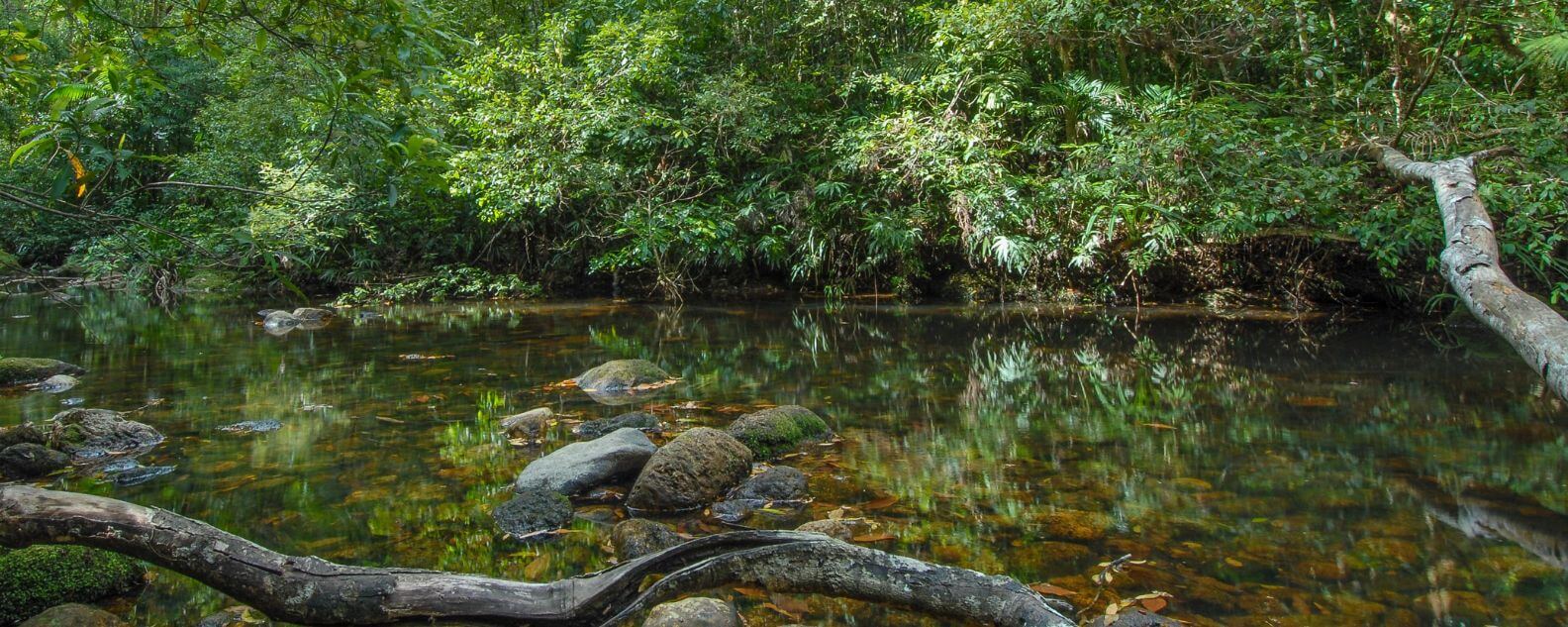
Connecting rainforest restoration researchers and practitioners
The recent Rainforest Connections 2024 conference is the first in over two decades dedicated to the restoration, rehabilitation and management of Australia’s unique rainforest habitats. The event connected 300 delegates from a wide range of backgrounds, including scientists, program managers, on-ground practitioners and community members.
Among delegates were four researchers and scientists from the Botanic Gardens of Sydney’s Research Centre for Ecosystem Resilience (ReCER).
Here they share their conference highlights and presentations, illustrating the diverse ways genomic research by ReCER is contributing to rainforest conservation and restoration.
Maurizio Rossetto – Gondwanan rainforest conservation
Head of ReCER Maurizio Rossetto gave a plenary presentation on ‘Temporal dynamics and assembly patterns of the Gondwanan rainforests, and implications for conservation.’
Maurizio shared a new macro-genomic study using an innovative multispecies genetic, functional and environmental dataset that aims to define the origins of current rainforest assemblages by investigating the relative contribution of current vs historical selective filters and dynamic process. He highlighted how co-distributed species don’t necessarily embody similar histories or respond to the same drivers, and that the distribution of evolutionary potential is not evenly distributed across extant rainforest vegetation. He outlined the implications of these results for conservation, including that different strategies should be considered for the management of different species (e.g., historically fragmented vs recently expanded) and different areas (e.g., refugia vs expansion corridors).
What presentation did you find most innovative or unique?
There were multiple presentations highlighting the use of new technology. For example, the emerging use of LiDAR to better estimate tree volume and demographics is particularly innovative. (See Manuela’s highlights below for more information).
What presentation gave you most hope?
It was promising to see so many presentations demonstrating the power of genomics and other emerging technologies in support of resilient restoration practices.
A conference moment/highlight you worth sharing?
Meeting with so many collaborators that I have known and worked with through the years and renewing our friendship and shared interests.
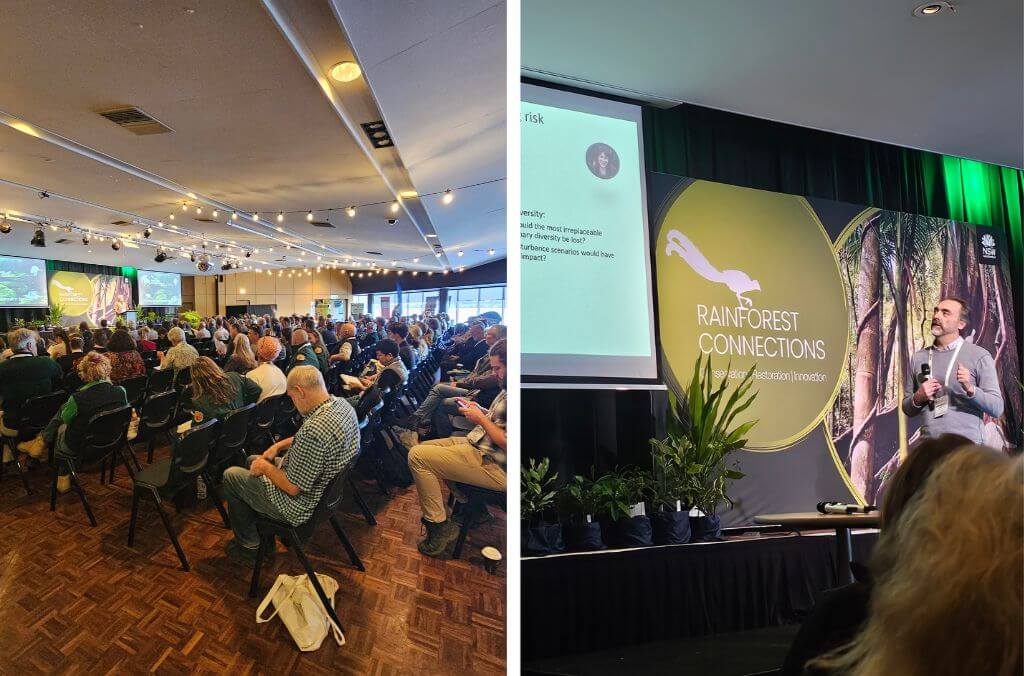
L: The conference brought together researchers and practitioners working to restore, rehabilitate and manage rainforest habitats. R: Maurizio Rossetto presents a plenary presentation.
Richard Dimon – Genomics and rainforest restoration
Technical Officer Richard Dimon delivered a presentation on the ‘Science saving rainforests project: Genomic workflows to inform provenancing of restoration material.’
Sourcing genetically diverse plant material is an important initial step for ensuring the long-term viability and overall success of restoration projects. Richard presented a workflow which helps practitioners decide where to source material for restoration based on genomic data and outlined newly developed optimisation analyses that help incorporate climate-resilient material in plantings. He demonstrated the practicality of this restoration workflow by presenting outcomes provided for the Science Saving Rainforests project, including design of seed production areas and genetically diverse insurance populations.
What presentation did you find most innovative or unique?
Mark Dumphy’s talk on converting Camphor Laurel regrowth using restoration plantings of secondary/late-stage successional rainforest tree species was particularly innovative. Co-founder of the Big Scrub Rainforest Conservancy, Mark gave a great talk discussing the benefits and practicality of transitioning from a dominant regrowth canopy of an invasive weedy species, into a diverse planting of late-stage successional rainforest species to help restore mature rainforests.
What presentation gave you most hope?
Hank and Sue Bower’s presentation on the restoration of oceanic rainforest on Lord Howe Island. They highlighted how successful outcomes that are continuing to be observed from the complete eradication of rodents from Lord Howe Island, resulting in positive benefits for birds, invertebrates, and overall plant diversity, particularly for highly endemic and threatened species found on the island.
A conference moment/highlight you worth sharing?
The overall popularity of the conference was a highlight for me. The conference was booked out with over 300 attendees ranging from government programs and scientific research groups to local Landcare and indigenous communities. The fact the last conference like this was held in 1998 made the event even more important, and although I did not attend the previous one (as I was 2 years old!), hearing people who did attend the previous conference talk about how far scientific research and collaboration between local communities has progressed since then has been promising to hear.
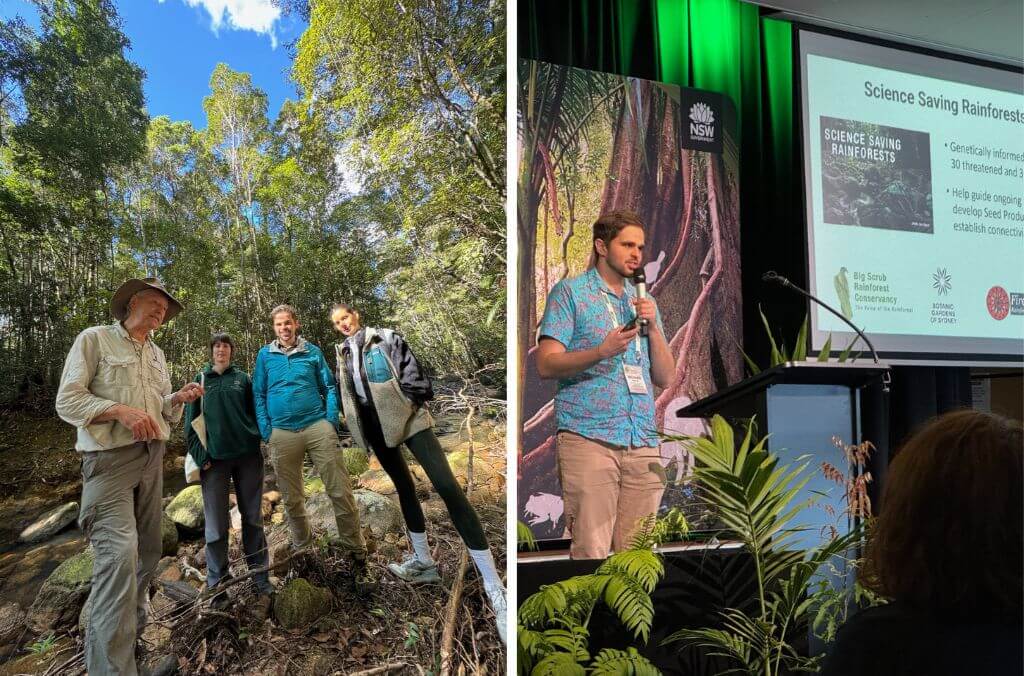
L: Long-term rainforest researcher Robert Kooyman alongside ReCER research staff on a field trip to Nightcap National Park. R: Richard delivering his presentation at the conference.
Manuela Cascini – Genomics and plant conservation
Scientific Officer (Biodiversity research) Manuela Cascini spoke about ‘Genomics in conservation: Case studies of threatened rainforest species and novel findings.’
Manuela’s presentation demonstrated the power of genome wide scans in conservation planning and management, reviewing case studies for threatened rainforest species to showcase how genomic information can provide an unprecedented understanding of Australian rainforest flora, offering pragmatic solutions for long-term conservation strategies. Genomic approaches, addressing previously unanswerable questions, are becoming more accessible due to cost reductions, especially in scenarios with constrained funding. You can find out more about ReCER’s work guiding threatened flora conservation here.
What presentation did you find most innovative or unique?
A presentation on validation of LiDAR based long term monitoring of rainforest structure and dynamics by Keith Cook from Arbor Meta. LiDAR (Light Detection and Ranging) is a remote sensing technology capable of collecting three-dimensional data. It can penetrate forest canopies, allowing for detailed characterization of both vertical and horizontal vegetation structures. The presentation demonstrated how LiDAR can be utilised to study rainforest structure and succession, which seemed really promising. The presentation also made me wonder about its potential applications in our conservation genomics work.
What presentation gave you most hope?
A talk by Lilly Clegg from the Yarrawarra aboriginal cultural centre (Girrimarring wiirrilgal bulany ngayanbading: Golden-tipped bat roost weaving project) gives me hope. Lilly is a Gumbaynggirr artist from Corindi Beach and her presentation was extremely enthusiastic and passionate. The Golden-Tipped Bat roosts on the underside of nests made by the Yellow-Throated Scrub Wren. A large number of nests were destroyed by bushfires, leaving a lot of bats desperate for a roost. The Yarrawarra aboriginal cultural centre have partnered with Muurrbay Langauge and Culture Co-operative and the NSW Department of Planning Industry and Environment to run workshops to engage local communities in re-creating these roosts using traditional weaving techniques.
A conference moment/highlight you worth sharing?
Lunch made by Rob Kooyman and served on the bumper of his ute during our field trip to the Nightcap National Park.
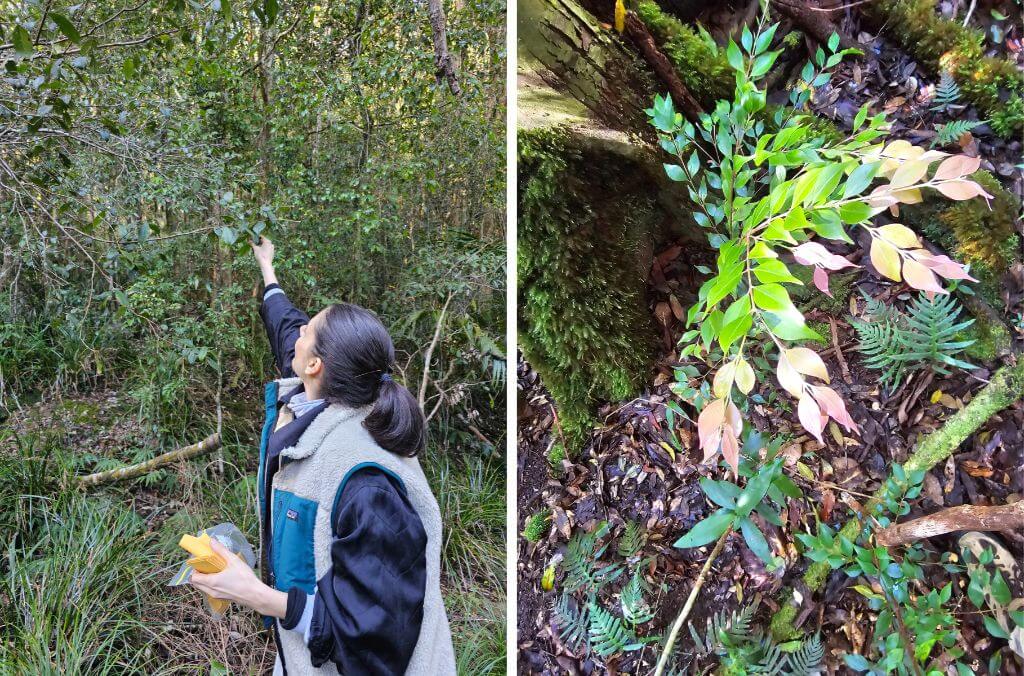
L: Manuela Cascini collecting a leaf sample for analysis from Lenwebbia prominens in Nightcap National Park. R: The endangered Uromyrtus australis is one of over 80 threatened plant species where genomic research is guiding conservation actions.
Monica Fahey – Genomics and cultural connectivity
Scientific Officer (Biocultural Plant Dynamics Research) Monica Fahey delivered a presentation on ‘Restoring the adaptive potential and cultural connectivity of edible rainforest trees’.
Monica discussed how stories told by Indigenous knowledge holders together with genetic and palaeoecological research suggest that past human populations played a significant role in some of the environmental changes that characterised the Holocene. Given this history of human intervention and the projected impacts of future climate change, Monica encourages restoration practitioners and conservationists to abandon ideals of “untouched wilderness” and embrace translocations where they can be useful and are culturally appropriate. She discussed how First Nations practitioners can collaborate with genomic researchers to co-design a restoration approach that aims to promote the adaptive potential of plant populations threatened by climate change and enhance their cultural connectivity with people and Country.
Read more about ReCER’s biocultural genomic research here and here.
What presentation did you find most innovative or unique?
I was very impressed by Julian Radford-Smith's talk ‘An ecophysiological basis for the assembly of Australian subtropical rainforest tree communities.’ He described how he conducted rainforest tree surveys and measured functional traits for a large number of species and found that the occurrence of species across a regional moisture gradient was strongly related to their hydraulic strategies. By revealing how climate, soil and biogeography have filtered tree strategies into communities across the subtropics, this project provides a basis for predicting the impacts of ongoing climate change and would be highly complementary to the genomics-based research on rainforest assembly that we do at ReCER.
What presentation gave you most hope?
There were a number of restoration success stories presented at the conference. For example, Hank and Sue Bower described how a total eradication approach has enabled the recovery of several plant and animal species on Lord Howe Island. The rat eradication story was particularly inspiring as it was a highly ambitious endeavour that required coordination over several years to respond to rat outbreaks and was mostly volunteer run. They successfully removed Myrtle Rust from the island twice!
It was also inspiring to hear the outcomes of various First Nations restoration projects. For instance the Jabalbina Yalanji rangers and Ellen Weber described how they learned to work with climate during revegetation projects following setbacks from a cyclone in 2022. The program enabled the professional development of many local Aboriginal people and has enabled the development of a natured based economy in the Wet Tropics.
A conference moment/highlight worth sharing?
Just the sheer enthusiasm of everyone in the room. Attendance was well balanced between practitioners and researchers, and it facilitated learning for both sides and I’m sure many collaborations will come of it.
... And seeing Eidothea for the first time in the wild!
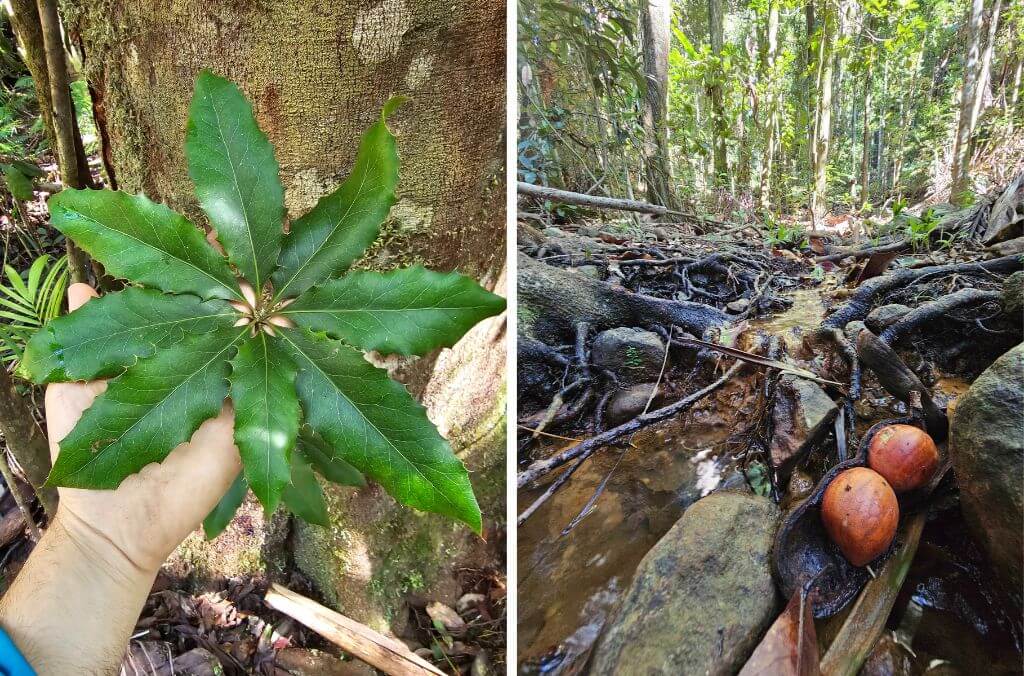
L: Seeing Eidothea hardeniana in the wild was a highlight for Monica Fahey. R: Monica spoke about restoring the adaptive potential and cultural connectivity of edible rainforest trees including Castanospermum australe (Blackbean).